Menus
- Heart transplantation and change of philosophy
- 853.4 cc 90 ° V-twin, 65 hp, 73 Nm
- Discovery
- In the saddle
- In the city
- Motorway and expressways
- Departmental
- Part-cycle
- Braking
- Comfort / duo
- Consumption
- Accessories
- Video test of the V7 850
- Conclusion
Heart transplantation and change of philosophy
853.4 cc 90 ° V-twin, 65 hp, 73 Nm
The Guzzi V7 is a discreet monument of the motorcycle planet and downright an icon for die-hard Guzzists. I’m obviously talking about the original model that appeared in 1967 since it was he who inaugurated the twin configuration facing the road (or transverse for lovers of technique) dear to the brand.. I’m not going to give you here all the history of the V7 since its birth – there is enough material to make several books – instead, we will jump directly to 2008, when Guzzi brings out his first “modern” V7. Finally, when I say modern, this machine is mainly released for marketing reasons. At the time, Mandello focused mainly on large displacement and he needed an attractive entry level to replace an endearing Breva 750 but a bit too expensive given its utility vocation. The idea – of genius – of Guzzi was therefore to let go of the “utility” segment (read: medium displacement not sporty) to jump on the bandwagon of vintage / neo-retro. If this V7 already seduced by its style, the antipollution standards of the time totally strangled its little V2 with the antediluvian design (air cooling, tumbled distribution, two valves per cylinder). It certainly did not slow down the early Guzzuists, who were already well versed in circumventing anti-pollution measures. But to win over new buyers who rely solely on what they read in the press, it was more complicated. Moreover, if we look in detail at the various evolutions of the V7 in 2012, 2015 and 2017, almost all of the evolutions relate to the engine-transmission assembly. It is therefore not a surprise that the new V7 inherits an 850cc engine block closely derived from that of the V85TT and the V9 battery when the Euro 5 standard comes into force. The old 750cc did his time…
 Moto Guzzi V7 850 Special review
Moto Guzzi V7 850 Special review
Discovery
If you have devoured our news section in recent weeks, you already know that the V2 850 cm3 develops 65 hp at 6800 rpm and 73 Nm at 5000 rpm, like the V9 vintage 2021. Compared to the 750, this represents respective increases of 13 hp (52 hp at 6,200 rpm previously) and 13 Nm (60 Nm at 4,250 rpm). Guzzi also promises that more than 80% of the torque is available from 3,000 rpm and that this new mechanism is both more flexible and less vibrator-like than before. Note that a restricted version for A2 license is still available in the catalog.
Admittedly, we are far from the 80 of the V85 but some of the technical novelties inaugurated on the Italian off-road are included here, in particular its partitioned engine crankcase with semi-dry lubrication and its oil pump with double rotor. The titanium valves are not in the game but the more compact distribution is there. There are also larger diameter intake valves (42.5 mm), aluminum rocker rods, lighter valve cams and a new profile camshaft. The clutch is a single dry disc type and its mechanism has been revised to reduce lever effort. As for the 6-speed gearbox, it has been reworked to offer more precision and reduce the noises of pinion clicks..
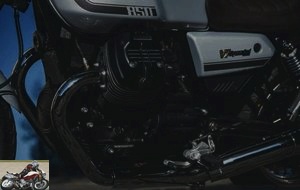 90 ° V-twin now 853 cc
90 ° V-twin now 853 cc
Now let’s move on to the cycle part. The architecture does not change with a removable double steel cradle but the torsional rigidity is increased by 10% via the grafting of reinforcing lugs at the level of the steering column. Another notable modification, the anchor point of the combined spring-shock absorbers has been moved to double the total travel of the rear wheel. Its modifications are completed by a longer swing arm (stung at the TT) and a reinforced bevel torque to take the increase in torque..
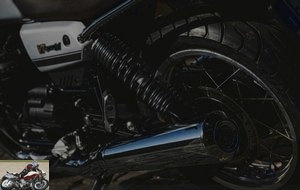 The double hydraulic shock absorber adjustable in preload
The double hydraulic shock absorber adjustable in preload
Ditto for the 17-inch rear wheel, its dimensions going from 130/80 to 150/70 to get everything on the ground without making you dizzy with the disconnectable traction control and adjustable on two levels.
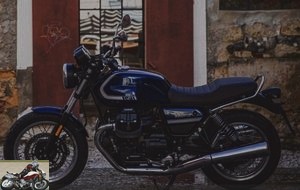 223 kg all full made for the V7 Special, 118 kg for the Stone
223 kg all full made for the V7 Special, 118 kg for the Stone
On the comfort side, the driver’s footrests are mounted on silent-blocks and the passenger is entitled to 10 mm of additional foam. Champagne! Another change ignored by Guzzi (you have to put the two technical sheets side by side to notice it), the hunting increases copiously, going from 26.4 ° to 28 °! All of these changes also affected the beauty’s weight. The full weight increases by 10 kg per version, or 218 kg for the Stone and 223 kg for the Special.
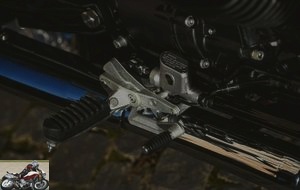 Footrests on silent-block now
Footrests on silent-block now
Suddenly I realize that I did not tell you about the differences between each variant. Before, it was pretty basic, spoked rims and chrome for the Special and spoke rims and matt paint for the Stone. For this generation, Guzzi has forced the line to better differentiate them.
The Stone, still devoid of chrome, is entitled to a specific digital dashboard and full LED lighting enhanced with a micro daytime running light (today, we talk about visual signature, that’s richer) evoking the eagle of Mandello. The spoked rims are made of aluminum and the sidewalls are adorned with a new “V7” logo. It should be noted in passing that Guzzi abandoned the Roman numerals to mark the difference between each generation, which is why everyone tends to call this version V7 850 and not V7 IV…
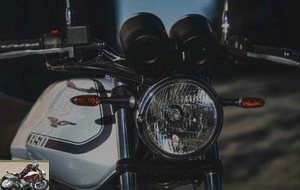 If the Stone opts for LEDs, the Special keeps its bulb headlight
If the Stone opts for LEDs, the Special keeps its bulb headlight
As for the Special (in italian in ze texte), it takes one more step towards neo-retro. In addition to the spoked rims, it is entitled to an analog dashboard with dual counters (there is still a small digital keypad to scroll through some essential information via the right commodo), milled cooling fins and a specific saddle brown decorated with a large chrome passenger handle.
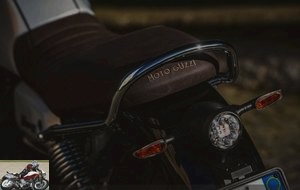 LED taillight with water drop indicators
LED taillight with water drop indicators
Each variant is available in three colors and the Stone is entitled as a bonus gift to a special Centenario edition, the specifics of which are detailed in the article in question..
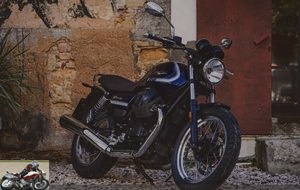 The Moto Guzzi V7 Special is priced at 9,599 euros
The Moto Guzzi V7 Special is priced at 9,599 euros
In the saddle
With a saddle height of 780mm and a relatively narrow seat at the junction of the tank, even the smallest riders should put both feet flat when stationary. The driving position is identical to that of the “old” V7. The handlebars are rather narrow, a bit too far away for my 170 cm.
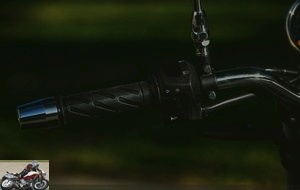 Commodos on a narrow handlebar and a little far for a small size
Commodos on a narrow handlebar and a little far for a small size
The large footrests (perfectly insulated, the silent-blocks are effective) are right in line with the buttocks, which means that you have to spread your legs to put your feet on the ground. Nothing serious, you get used to it, but this detail can be irritating on the first kilometers. At startup, the twin has a rather quiet voice (it improves higher in the turns) and each gas stroke is accompanied by a small pitch from left to right. Phew, the twin reversal couple is still there, the tradition is saved.
Depending on the model chosen, you will have a different dashboard in front of you but both are legible and clear. My preference goes to that of the Stone, more readable in strong light. It is also more complete and more easily configurable than that of the Special.
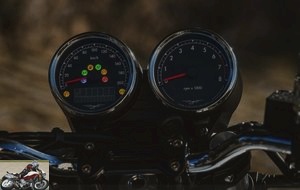 On the Special, the double counter is very classic vs the digital counter of the Stone
On the Special, the double counter is very classic vs the digital counter of the Stone
Nothing to say about the mirrors or the rest, everything is in the standard or beyond, with the congratulations of the jury. Same remark for the finish, it’s good, even very good in places, but nothing stunning given the premium placement claimed by Guzzi.
In the city
The clutch is soft, the box precise as promised in the press kit and especially the travel of the selector is FINALLY normal. I can’t count the number of times I’ve fallen into a false dead point with the older generation because I didn’t twist my ankle enough to get into gear…
Other good news the 850 cm3 is ultra flexible, accepting to resume at 2000 laps on the last two reports. On the other hand, the torque at low revs is both pleasant and … disappointing on the first kilometers. Let me explain: this V850 looks like a turbo diesel; three millimeters on the throttle ensure good revivals in the first third of the tachometer but if you screw the grip wide, you will not have much more. So, yes, there is torque at the bottom but for hearty raises – or at least as high as what the spec sheet says – the higher you are in the laps, the better. This twin is neither hollow nor pointed but it only starts to give the best of itself from 4000 – 4500 rpm. It’s quite radically different from the old 750 block which had already given everything at 5000 laps … For the rest, no complaints. The low placed weight facilitates maneuvering and stability at low speed, the twin resumes almost from idle in first reports, the turning radius is average and the settings on the angle do not require special effort on the handlebars . We are far from the foaming urban of a scooter but for a machine of more than 200 kg, the V7 is doing very well in this exercise..
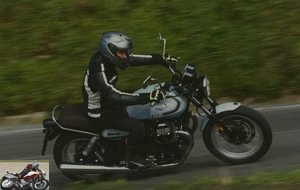 65 hp (48 kW) at 6,800 rpm
65 hp (48 kW) at 6,800 rpm
Motorway and expressways
The day before, we tested the Aprilia Tuono 660 at a very sustained pace on expressways. With the V7, the pace was worthy of recognition on a Moto Tour. Not dangerous but it is rare to see one of his chaperones signaling you to accelerate when you are already at the speed limits … and I am not talking about legal speeds. And then the rather peaceful vocation of the V7 does not really lend itself to this kind of jokes. The good news is, this Guzzi is a high speed rail. Of course, you get shaken on the huge bumps (not ideal when you ride with two broken ribs as I was, after crashing that morning on my stairs) but the V7 has never deviated from it. ‘a millimeter from its trajectory. The top speed above 180 km / h is useless but it is the guarantee that the engine will not grind on the last report while crumbling to 130. Without screen (optional, do not count on driving much faster , the non-existent protection and the inability to push on the footrests (too far forward) to counter the wind pressure quickly become tiring.
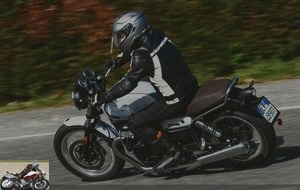 a high speed rail
a high speed rail
Departmental
As much to tell you right away, contrary to what Guzzi announces, the comfort has not really been improved because the suspensions are always firm type. But it’s still better than before. The rear suspension is not downright less dry on small shocks and the double travel of the rear wheel (it goes from 90 to 180 mm) is a real plus. It’s firm but never uncomfortable. And to follow the forerunners, perched on TT85s, you need good arms to go from one angle to another. The small handlebars, practical in town, show their limits here. Another limiting factor, the ground clearance ended up quickly missing. It’s much better than a custom but as the chassis is ultra healthy, we would like to have a little more…
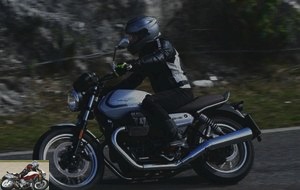 Ground clearance that quickly reaches limits
Ground clearance that quickly reaches limits
Then there is the engine. For a person used to 750 cm3 blocks, the sensations are confusing. I even said to myself during the first few kilometers: "what is this enema pear?" Logically, before, everything happened between 2,500 and 5,000 laps. If we follow the same instructions, on the 850, we have the impression of driving on an A2 flanged version … The fact that the shift light (set very low in factory setting, breaking in requires) constantly flashing in the face also misled me. In fact, the optimum range of use has shifted significantly higher; between 4500 and 7000 revolutions !
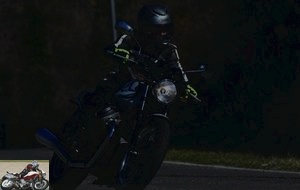 A higher range of use, ideal between 4,500 and 7,000 revolutions
A higher range of use, ideal between 4,500 and 7,000 revolutions
Once integrated the new user manual, it’s party time. The very full torque curve (so up) makes it possible to hesitate between two reports on a blind corner entry and the thrust is copious. Yes, the 850 cm3 is much more efficient and the chassis could largely take more horsepower. The front axle is stable, precise, the driving rear and absorbs all the bumps of the road. In short, it’s healthy and efficient, but not really sporty. And anyway the brakes show their limits far too quickly in this kind of exercise, with the single disc at the front which would have deserved to be doubled..
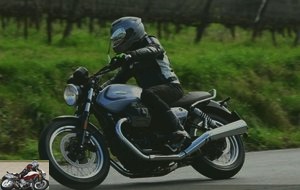 A significantly more efficient 850 cm3 and a chassis capable of handling more power
A significantly more efficient 850 cm3 and a chassis capable of handling more power
Part-cycle
The V7 has been wheeled over time. The dry weight has dropped from 179 kg (2008) to 198 kg today. In real life, this translates into a curb weight of 218 kg for the Stone and 223 kg for the Special, which is ten kilos more than the previous generation … Add to that a more open hunting angle and you get a machine of unwavering rigor in large curves but physical to take in the changes of angles. If the handlebars were a little higher and a little wider, the additional lever arm would make it possible to erase this but Guzzi wanted to keep the same triangle saddle handlebar footrest. The most ironic thing in all of this is that Guzzi does offer a handlebar in its option catalog. But these are even lower and narrower bracelets. Go figure Charles…
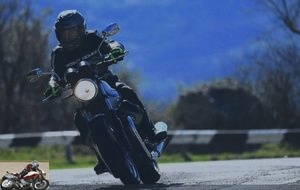 Unwavering rigor in large curves but physical to take in the changes of angles
Unwavering rigor in large curves but physical to take in the changes of angles
Braking
The braking system has not changed one iota on this generation. At the front there is therefore a single 320 mm diameter disc (floating) clamped by a 4-piston Brembo caliper and a 260 mm fixed disc coupled to a 2-piston caliper behind. This is sufficient at normal pace and for emergency braking (well, at least one), much less if you are late at work and have to go home either before curfew. Nothing to say about the initial bite but the power ends up lacking on heavy braking and the feedback to the lever is nothing transcendent. The good point comes from the rear brake (once is not customary), easy to dose and very practical in town to help in maneuvering in town at very low speed.
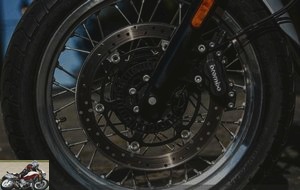 Single 320mm stainless steel floating disc, Brembo calipers, but a bit tight
Single 320mm stainless steel floating disc, Brembo calipers, but a bit tight
Comfort / duo
Well, in all fairness, I didn’t have a single second to get into the passenger seat and the overall firmness in the front shouldn’t vanish with a wave of a magic wand with 10mm more foam underneath. the foundation … After that, you have to put things in perspective. The Roman bitumen was really execrable and the cold – which tends to freeze the oil in the suspensions – as well as the combination of gravel + salt crust on the road (which tends to make it fall) are not at all representative of the state of the French road network. So let’s not judge this new V7 too harshly, it will be much more liveable here….
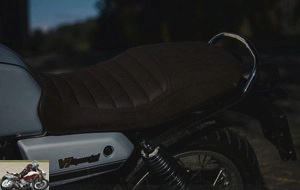 Rustic comfort despite the thickness of the two-seater seat, with passenger handle on the Special
Rustic comfort despite the thickness of the two-seater seat, with passenger handle on the Special
Consumption
Despite its reduced dimensions, the tank of the V7 can hold 21 liters (including 4 reserve). The official consumption (WMTC cycle) is announced for 4.9 l / 100 km so the theoretical autonomy is about 430 km. Bad luck, the on-board computers of our V7s were all buggy according to Guzzi officials. But if we base ourselves on the figures noted by Damien during his test of the more powerful and logically more greedy V85 TT, the actual consumption varies between 5.5 and 6.5 l / 100 km. Enough to do 350 km on average between two pump runs.
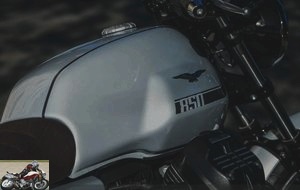 21-liter tank, for nearly 400 km of autonomy
21-liter tank, for nearly 400 km of autonomy
Accessories
Guzzi offers a catalog of accessories as thick as a directory. I don’t put everything here so don’t hesitate to visit the Guzzi site if you want to know more…
Red cylinder head covers, tubular engine shield (chrome or black), rubber tank protectors center stand, Sport handlebars and half-handlebars, windshield, heated grips, side bags in leather, canvas and touring, integrated luggage rack two passenger handles, range of saddles (6 versions and waterproof variants).
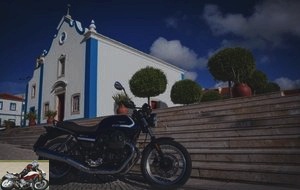 Moto Guzzi V7 Special 2021
Moto Guzzi V7 Special 2021
Video test of the V7 850
Conclusion
Objectively, this new V7 “850” improves in all areas compared to the old one. More power, more torque, a better cycle part, a soft and well-guided gearbox with (finally) reduced travel. And the greater differentiation between Stone and Special is welcome. As for the price increase *, it remains marginal in view of all the changes made to this vintage. But (there is always a but) if this new V7 erases most of the faults addressed to the previous generation, it reveals new ones: the heavier weight, the stiffened chassis and the increased performance update the weaknesses braking and the physical side of the chassis as soon as you increase the pace. And then there is also the “new” driving character which will confuse regulars. And, personally, I find that, as it is, the twin 850 cm3 has less charm than the 750. But this opinion (very subjective) is not definitive. A large twin, which is more old-fashioned, takes a long time to reach maturity. Besides the break-in, it does not really release until after 5000 km and always gains a big ladle of torque and power when it reaches the mark of 8-10,000 km. Always ! There, with 250 km on the clock, it is impossible to definitively judge the engine character of this new V7….
*: € 9,199 for the Stone (2018: € 8,549) and € 9,599 for the Special (2018: € 9,199)
Strong points
- Performances
- Part-cycle
- Autonomy
Weak points
- Suspensions
- Braking
The technical sheet of the Moto Guzzi V7 850
Test conditions
- Itinerary: small varied roads + interurban highways with a bit of town
- Motorcycle mileage: 300 km
- Problem encountered: About 50% of the testing machines were subject to untimely stalls just after starting
Related articles
-
Moto Guzzi Bellagio Aquila Nera test
The beautiful stranger Lovers of original roadsters and strong customs, the Moto Guzzi Bellagio has everything to seduce you. A machine that goes back in…
-
Moto Guzzi California 1400 custom test
The myth revisited If for you the Moto Guzzi California only evoked pure tourism, the new 1400 Custom will make you change your mind ….. Tackling a…
-
Harley-Davidson Road King Special test
V2, 1745 cm3, approx. 90 hp at 5500 rpm, 150 Nm at 3250 rpm, 355 kilos dry, from € 25,390 The Dark Custom spirit touches the queen of the road Discreet…
-
Chinese competition Parallel twin of 649 cm3, 70 hp and 62 Nm, 226 kg full made, Metzeler tires, J. Juan brakes, Bosch ECU, Continental ABS, YUAN…
-
A new path 90 ° V-Twin, 853 cm3, 80 hp, 80 Nm, 229 kg full made, 23 liter tank, € 11,699 What is a new motorcycle? First a new engine and an adapted…
-
Made for Milan and beyond Twin-cylinder 1.187 cm3, 115 hp and 108 Nm, 191 kg dry, from 15,000 euros Not so long ago, the small but historic Italian brand…
-
It’s bathed in oil ! Currently available in three versions, the Moto Guzzi V7 benefits for 2014 from minor technical and cosmetic changes. The…
-
Moto Guzzi Nevada Aquila Nera test
A world of sweetness Charming in its black dress, the 750 Nevada is beautiful but wise for a 750 twin. A Moto Guzzi-style custom, that is to say that…
-
Moto Guzzi California Aquila Nera test
The stripped down version of the Calif ‘for 3000 euros less If for you the California evokes the motorcycles of the American police, you will be…
-
Test Moto Morini Granpasso 1200
The big original trail Do you like long-distance trips and motorcycles that are both original and efficient? Moto Morini may have a model to seduce you:…
"A pit! Driving calmly at authorized speeds, no less than 10 l / 100. The most enraged at the gas handle even happily reach 17 l / 100….
Well sheltered behind the bottom of the cylinders, the 3 Mikuni 30mm carburettors are as simple as … greedy! "
No matter what, on the motorway at 130 km / h, you don’t have to turn the throttle much and instead consume 8 l / 100 km.
It is probably one of the most successful motorcycles aesthetically (the top with the double front disc) and mechanically. An excellent compromise, which is a model for all motorcycles, including today.
There were great opportunities to be had at the very beginning of the 80s, it was still a benchmark model despite the appearance of "modern" motorcycles.
nice. she’s not ugly in green.
tom4
As soon as I heard about this version of the H2, I told myself that finally my dream of a low-displacement turbocharged sport-gt would fulfill my wishes:
– Weight content,
– Couple at low speed,
– Consumption content.
Well, after reading the article, I keep my K1200S in full legal, similar weight, lower consumption (I make between 5 l and 5.5 l), more torque and I have ESA which allows to pass the settings solo suspension, torque in less than 5 s, the cardan transmission that goes well for this type of use…
Anyway, it could really have revived this category of motorcycle, which I find gloomy since the end of the K1300S.
Dblz> a priori the original tire of the V7 is really rotten .
.
You have to be wary of preconceived ideas, Yannick: the H2 SX SE is still a bit GT (fast, of course). Its driving position is less radical than a ZZR or a Hayabusa (we are close to that of a VFR 1200), its engine is very flexible at low speed and the suspensions also know how to provide a certain flexibility … knowing how to stay wise on the handlebars, that’s another problem !
Philippe
Ah but a few months ago we could read quite often in the comments (of recent permits) that traction control was essential, all that, that it was enough once, all that…
Obviously this is not wrong, but to wonder if we do not scare them with that to the license.
Sticking that on a motorcycle, it allows it to slip into the com ‘to praise the modern equipment of the motorcycle, and it allows (by cynically marketing two cents) to put cheap tires on it..
That said, these two Guzzis are not bad at all.
And I never slipped in the rain in Mac100X…
According to Kawasaki, the Ninja H2 SX considers it the sportiest touring of all its models. "The queen of the highway", as they called her.
<u><a href = "[Kawasaki" target = "_ blank"> http://www.lerepairedesmotards.com] H2 SX SE</ a></ u>. In itself it looks a lot like an H2 on the outside with some changes, but from its spec sheet I can see that the internal changes have been quite interesting. I understand that despite this great power that comes with 210hp and 998cc, the throttle response is smooth and not a runaway bull.
On this basis, it can be a motorcycle that arouses interests in France, as in the past.
According to Kawasaki, the Ninja H2 SX considers it the sportiest touring of all its models. "The queen of the highway", as they called her.
H2 SX SE. In itself it looks a lot like an H2 on the outside with some changes, but from its spec sheet I can see that the internal changes have been quite interesting. I understand that despite this great power that comes with 210hp and 998cc, the throttle response is smooth and not a runaway bull.
On this basis, it can be a motorcycle that arouses interests in France, as in the past.
Can anyone tell me ?
I still do not understand why in the car tests it is clearly displayed the 0 to 100, the times and especially the top speed while for the bike, that dal …. Pure discrimination …. We have the right, what am I saying, it is necessary to clearly display the 340km / h of the Ferrari 812, whereas to say that the Hayabusa takes what …. What besides ?? Anyone know how hard she takes ?? In the name of what right this differentiation ???